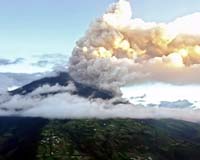| . |  |
. |
Taal Volcano, Philippines (AFP) May 10, 2011 Boats lay idle on the shores of a lake surrounding the Philippines' rumbling Taal volcano as village elder Violy Seda retold her dramatic escape from death a generation ago. The 65-year-old woman was a young mother during Taal's last major eruption in 1977, which covered the island with deadly ash, violently shook the ground and sent villagers rushing through the night to their boats to escape. "Throughout the day there were powerful earthquakes that sent us falling over ourselves," said Seda, who now has seven children and 32 grandchildren. "By nightfall we had packed everything and jumped on our boats just as a loud bang erupted. The night sky glowed and we would have died if we stayed behind." No one was killed in that eruption, and the villagers soon returned to ply their trade as tour guides on the island, the most active among the Philippines' 23 volcanoes and just 65 kilometres (40 miles) south of Manila. Now the volcano is threatening to erupt again, but the few thousand people living there are undaunted by the latest signals and are again refusing to leave unless a major eruption looks certain. "I grew up here and all my children were born on this volcano. These rumblings are normal for people like us," Seda said. Taal is famous for its distinct crater lake. It is a 23-square-kilometre (14-square-mile) volcano island that lies inside a bigger lake formed from previous volcanic activity. Together they are among the most spectacular sights, and popular tourist destinations, in the Philippines. Most of the residents on the island work in the tourism sector. They ferry tourists across the lake from towns encircling the island, and provide guided treks and horse rides up its main crater for about 500 pesos (less than $10) per person. But with 47 craters and its history of powerful explosions, Taal is classified a "permanent danger zone", according to government volcanologists. It has erupted at least 33 times since 1572, the most destructive of which was in 1911 when it left 1,334 people dead, sent ash falling on to Manila and triggered wave surges that engulfed entire lakeshore villages. A recent surge in seismic activity on the island forced state volcanologists to hoist the second of a five-step alert system on April 9. This meant magma may be slowly moving up its crater, ahead of a possible explosion. All tourist activity was halted and authorities called for the elderly and the young to be evacuated. Boatman Gregorio Enriquez, 41, explained that the villagers had decided to remain because they had nowhere else to go, and they could only hope the seismic activity would soon subside so the tourists would return. "You can always try to outrun an explosion, but you can never beat poverty as a result of the alert status," Enriquez said. Enriquez, a father of two young girls, said he typically earned about 3,000 pesos (about $70) ferrying tourists, although his boat had been idle for a month. Villagers are now subsisting on local carp caught from the lake and vegetables from their plots. Without cash from tourists, rice, the staple food sold in towns across the lake, is mostly beyond the reach of the poor villagers. "Life for the past month has become a monotonous cycle of waiting, sleeping and more waiting," Enriquez said. With him in a makeshift shed were about a dozen members of his extended family, all of them waiting for the clan's patriarch to return from buying a sack of rice with savings made during better times. Children splashed in the lake while the family-owned horses were tethered on nearby coconut trees, their heads bent low from the tropical noon-day heat. Migrating egrets and gulls fought off crows for scraps of fish lying on the otherwise lifeless beach front. "This volcano is both a blessing and a curse for us," lamented Enriquez. At the local tourism office, a huge yellow sign proclaimed that the entire island remained on alert for possible eruption, and no tourist activity was permitted. "We haven't had any tourists setting foot here for the past month. The only (people) that have visited are volcanologists and the press," complained Susan Mameng, the island's tourism officer. "People here are getting desperate. What is ironic is that the island is alive, and yet we may be slowly dying if we don't get tourists back," she said.
Share This Article With Planet Earth
Related Links Bringing Order To A World Of Disasters When the Earth Quakes A world of storm and tempest
 Ecuador on alert after volcano erupts
Ecuador on alert after volcano eruptsQuito, Ecuador (UPI) Apr 27, 2011 Ecuador declared a national alert after the Tungurahua volcano, notorious for previous eruptions, began spewing lava again, forcing closure of schools and a widening evacuation of residents. There were no immediate reports of casualties from the latest eruption. A 5-mile-high column of lava and ash generated a vast, stifling canopy of poisonous gases and smoke, forcing the author ... read more |
|
| The content herein, unless otherwise known to be public domain, are Copyright 1995-2010 - SpaceDaily. AFP and UPI Wire Stories are copyright Agence France-Presse and United Press International. ESA Portal Reports are copyright European Space Agency. All NASA sourced material is public domain. Additional copyrights may apply in whole or part to other bona fide parties. Advertising does not imply endorsement,agreement or approval of any opinions, statements or information provided by SpaceDaily on any Web page published or hosted by SpaceDaily. Privacy Statement |